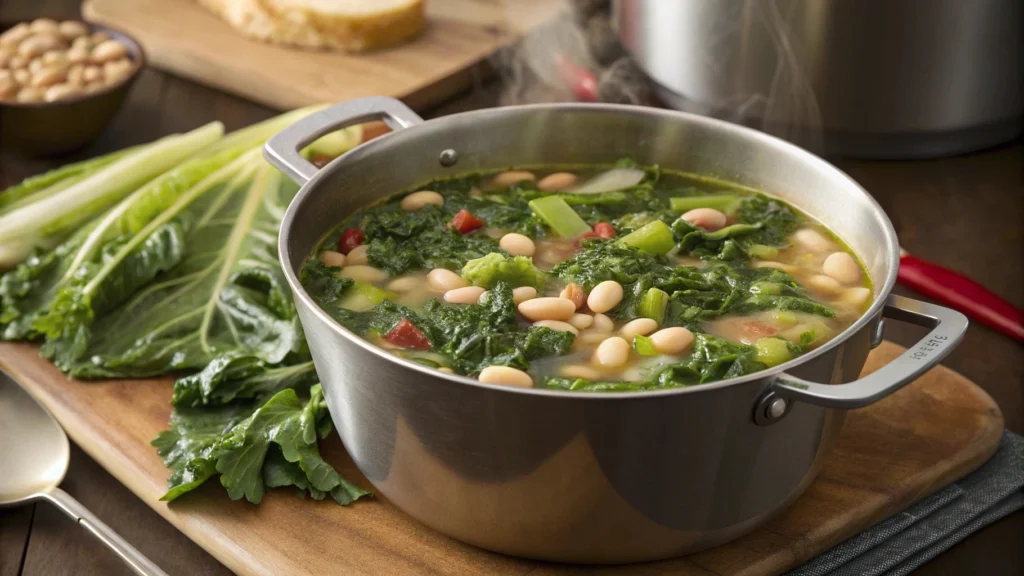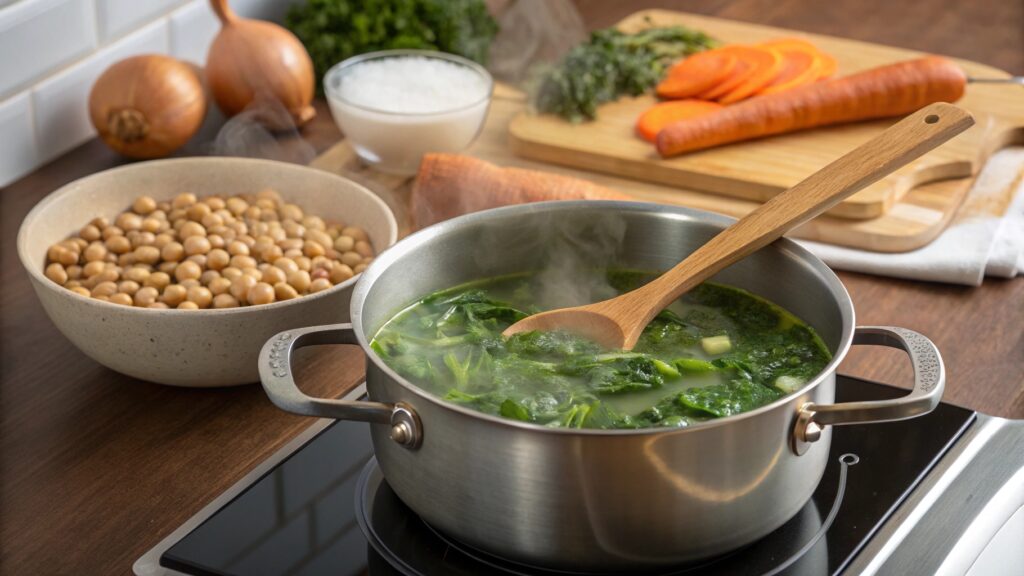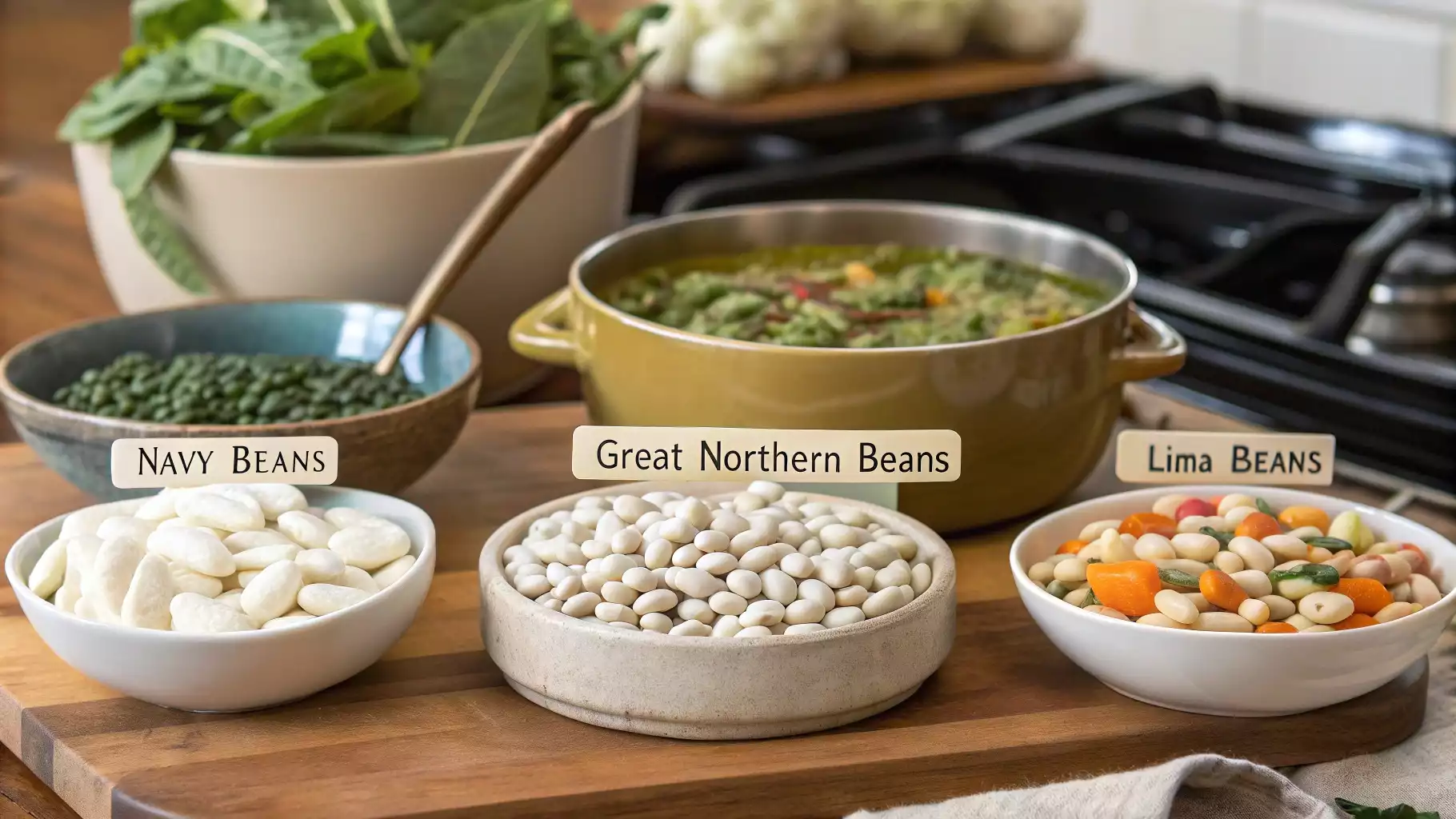What Kind of Beans Go in Turnip Green Soup? Turnip green soup is a flavorful and hearty dish that combines tender greens with various ingredients. Among its key components, beans stand out as an essential addition. Beans not only add texture and protein but also enhance the flavor of the soup. Depending on the type of beans used, the soup can take on different qualities, ranging from creamy and mild to hearty and bold. The choice of beans plays a significant role in shaping the final dish.
Table of Contents
Best Beans for Turnip Green Soup
White Beans (Navy, Cannellini, Great Northern)
White beans are one of the best options for turnip green soup. Their mild flavor and creamy texture help absorb the broth’s taste, making the soup rich and well-rounded. These beans have a delicate flavor that doesn’t overpower the greens, making them ideal for a balanced dish.
Black-Eyed Peas
In Southern cooking, black-eyed peas are a classic pairing with turnip greens. These beans bring an earthy, slightly nutty taste to the soup. They complement the greens perfectly, creating a comforting and robust flavor profile. Their creamy texture also adds a nice contrast to the tender greens.
Pinto Beans
Pinto beans are another great choice for turnip green soup. Their hearty, slightly smoky flavor pairs well with the earthiness of the greens. Pinto beans also contribute to a thicker, richer texture, making the soup more filling and satisfying.
Kidney Beans
Kidney beans offer a bold flavor and firm texture that works well in turnip green soup. Their rich taste adds depth to the soup, while their firm structure helps them hold up during the cooking process. These beans are an excellent source of protein, making them a great addition for a more substantial dish.
Chickpeas (Garbanzo Beans)
Chickpeas add a slightly nutty flavor and a firm bite to turnip green soup. Although not a traditional choice in Southern-style soups, chickpeas can provide a Mediterranean twist. Their dense texture and subtle flavor enhance the soup without overshadowing the other ingredients.

How to Choose the Right Beans for Turnip Green Soup
Canned vs. Dried Beans
When deciding between canned or dried beans for your turnip green soup, there are a few key factors to consider.
Canned Beans are a quick and convenient option. They’re pre-cooked and ready to add to your soup, which can be a major time-saver when you’re in a rush. However, canned beans tend to be softer and may break down during cooking, resulting in a slightly mushier texture. They also often contain added sodium and preservatives, so it’s important to rinse them thoroughly to improve the taste and reduce excess salt. Additionally, canned beans may not absorb the broth’s flavors as well as dried beans do, which means your soup might lack a certain depth of flavor.
On the other hand, Dried Beans require a little more preparation, but they are well worth the effort. They need to be soaked before cooking to soften and shorten the cooking time. Once soaked, dried beans cook more slowly and absorb the flavors of the broth and seasonings much better. This gives the soup a richer, more authentic taste. The texture of dried beans is also firmer and heartier, providing a satisfying bite to the soup. While the cooking process is longer, many people find that the flavor and texture of dried beans are superior to canned beans.
If using dried beans, it’s best to soak them overnight or for at least 6-8 hours before cooking. After soaking, simmer the beans until they’re tender, which could take 1-2 hours depending on the variety. If you’re short on time, a quick soak method—boiling the beans for a few minutes and then letting them sit for about an hour—can also work.
Mixing Different Types of Beans
Blending different types of beans can add complexity and enhance both the flavor and texture of your turnip green soup. The combination of beans provides a variety of textures that make the soup more interesting to eat. For example, pairing creamy white beans (like cannellini or Great Northern beans) with hearty kidney beans can create a well-balanced dish. The creamy texture of the white beans contrasts nicely with the firm, hearty texture of the kidney beans.
You can also experiment with beans that have different flavors. For instance, mixing pinto beans, which have a slightly smoky flavor, with black-eyed peas, which are earthy and nutty, will create a more complex soup. The different beans work together to build layers of flavor, giving the soup more depth and making it more satisfying.
Additionally, mixing beans allows you to adjust the soup’s consistency. For example, chickpeas (garbanzo beans) are a bit firmer and retain their shape well, adding some bite to the soup, while pinto beans break down slightly, thickening the broth and making it more velvety.
When mixing beans, it’s essential to cook them separately before adding them to the soup if you’re using dried beans. This ensures that each type of bean is cooked to perfection and maintains its unique texture. If using canned beans, adding them at different stages of the cooking process can help maintain their individual textures and prevent them from overcooking.
By blending beans, you can customize the soup to your personal preferences and create a well-rounded dish that satisfies both the palate and the appetite. Whether you prefer a creamier soup or one with a heartier bite, the right combination of beans can make all the difference.
Cooking Tips for Adding Beans to Turnip Green Soup
When to Add Beans to the Soup
The timing of when you add your beans to the soup is crucial to achieving the perfect texture. For canned beans, it’s best to add them towards the end of the cooking process. Canned beans are already cooked, so adding them too early can cause them to break down and become mushy. Instead, wait until the turnip greens are tender and the soup has had time to develop its flavor. Stir the beans in about 10-15 minutes before the soup is finished cooking, just enough time to heat them through without compromising their texture.
For dried beans, the situation is different. Dried beans need to be added early in the cooking process, as they require longer cooking times. If you’re using dried beans that you’ve pre-soaked, add them to the pot at the same time as your turnip greens or a bit earlier. This will allow the beans to cook through, absorb the flavor of the broth, and soften to the perfect consistency. If you’re not soaking your beans, be sure to simmer them in the soup for 1-2 hours to ensure they’re tender and flavorful.
By adding beans at the right time, you can ensure they cook properly and don’t end up either too mushy or underdone.
Seasoning Beans for the Best Flavor
Seasoning is key to bringing out the best in the beans and complementing the turnip greens in your soup. Start with garlic and onion, which serve as the flavor base for many Southern-style dishes. These ingredients provide depth and help to elevate the natural flavors of the beans. Sautéing the onions and garlic in a bit of oil or butter before adding them to the soup ensures they’re softened and aromatic, releasing their essential oils and sweetness.
For an additional flavor boost, add smoked paprika. This seasoning imparts a smoky, earthy taste that pairs wonderfully with both the beans and the turnip greens. Smoked paprika can mimic the richness that comes from using smoked meats like ham hock or bacon, making it a great vegetarian-friendly alternative for flavor. If you enjoy a little heat, red pepper flakes or a dash of hot sauce can introduce a subtle spiciness that balances out the slight bitterness of the turnip greens. Feel free to adjust the seasoning to your taste, adding more or less as you go.
If you’re aiming for a more savory and aromatic broth, experiment with thyme, bay leaves, and black pepper as well. The combination of seasonings should be rich but balanced, allowing the beans to shine while complementing the greens.

Using Broth for Extra Depth
The broth you choose to cook your soup in plays a significant role in its overall flavor. A rich broth will give your soup the depth it needs to taste full and satisfying. You can use chicken broth, vegetable broth, or even ham broth depending on your preference and dietary restrictions.
- Chicken broth is a versatile choice that brings a light but savory base to the soup. Its mild flavor enhances the beans without overpowering the dish.
- Vegetable broth is a great option for those seeking a vegetarian or vegan soup. It provides a neutral, earthy base that allows the turnip greens and beans to stand out.
- Ham broth, however, is a favorite in Southern cooking. The rich, smoky taste of ham-infused broth pairs beautifully with the beans and greens, adding a layer of savory depth that ties the entire dish together. If you’re using ham or bacon in your soup, incorporating some ham broth will elevate the flavor and create a more cohesive, hearty dish.
To really deepen the flavors, consider simmering your soup slowly. The longer you cook it, the more the beans and greens will absorb the flavors of the broth, creating a rich, flavorful base that’s sure to impress.
By using the right broth and taking time to season your beans properly, you’ll ensure your turnip green soup has a perfect balance of flavors and textures. These simple yet effective tips can take your soup from good to great.
Common Mistakes to Avoid When Using Beans in Turnip Green Soup
Overcooking or Undercooking Beans
One common mistake when making turnip green soup is overcooking or undercooking the beans. Beans should be tender but not mushy. To ensure they reach the perfect texture, cook them slowly and check frequently.
Not Rinsing Canned Beans
It’s important to rinse canned beans before adding them to your soup. This removes excess sodium and any preservatives, improving the overall taste of the soup.
Frequently Asked Questions (FAQs)
Can I use frozen beans in turnip green soup?
Frozen beans can be used, though they may have a slightly different texture compared to fresh beans. Be sure to thaw them before adding to the soup.
How long should I cook dried beans before adding them to soup?
Dried beans should be soaked overnight or for at least 6-8 hours. After soaking, cook them for 1-2 hours until they’re tender, depending on the type of bean.
Are there low-carb bean alternatives for this soup?
Yes, you can use alternatives like green beans or edamame for a lower-carb version. These beans provide a similar texture without the high carb content.
What is the best seasoning for beans in turnip green soup?
Garlic, onion, smoked paprika, and a touch of cayenne pepper work wonderfully with beans in turnip green soup. These seasonings enhance the flavor of the beans and the greens.
Can I make turnip green soup without beans?
Yes, you can make turnip green soup without beans, though it will lack the hearty texture and protein that beans provide. You can substitute beans with other vegetables like potatoes or squash.
Conclusion about What Kind of Beans Go in Turnip Green Soup?
Turnip green soup is a versatile and satisfying dish, and the beans you choose play a crucial role in shaping its flavor and texture. Whether you prefer white beans for a creamy texture, pinto beans for a smoky depth, or kidney beans for boldness, there’s a perfect bean for every palate. Experiment with different combinations, and don’t be afraid to explore new variations. The possibilities are endless, and your taste buds will thank you for it!

